Samsung Galaxy Nexus & Ice Cream Sandwich Review
by Brian Klug & Anand Lal Shimpi on January 18, 2012 1:34 PM ESTBattery life remains the other big axis on which smartphones are judged, and here we've turned to our regular 2011 suite of battery life tests to see how the Galaxy Nexus shakes out. Our battery life testing consists of a page loading suite which loads through a few dozen pages endlessly on both WiFi and cellular data until the phone dies, with the display set at 200 nits. For the cellular tests, we're always careful to test in cellular environments with decent signal (at least -75 dBm or higher) as well, since that's a factor. Next is a simple call test where we play music at both ends of a call until the device under test dies, and our final test is a WiFi hotspot workload which consists of four page loading tabs and a 128 kbps streaming MP3 station that runs until the phone dies.
First up are the web browsing tests over cellular 3G; this means EVDO Rev.A for the CDMA/LTE version, and WCDMA T-Mobile for the GSM/UMTS device.
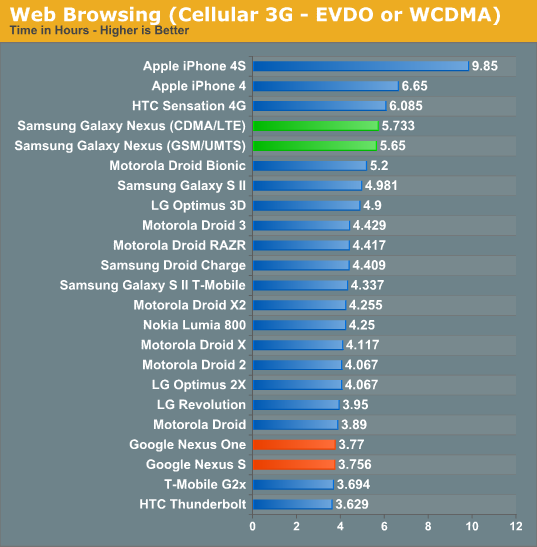
The Galaxy Nexii both do surprisingly well. I'm actually very impressed with how long the devices lasted subjectively on 3G and this definitely backs that up. Of course, both devices include beefy batteries, but Samsung has done a nice job thus far including big batteries without making devices bulky or heavy.
Next up is the same test, but on 4G LTE for the CDMA/LTE variant.
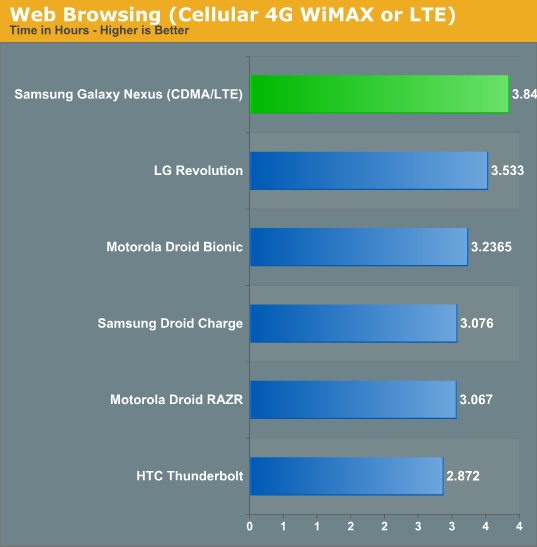
The Galaxy Nexus doesn't post numbers very far in front, but manages to come in the top of the pack on 4G LTE at just under 4 hours. This is a pretty impressive result, honestly, considering that CMC221 is likely made on the same 45nm manufacturing process as CMC220. Again, I'm impressed with the Galaxy Nexus' longevity even on 4G LTE.
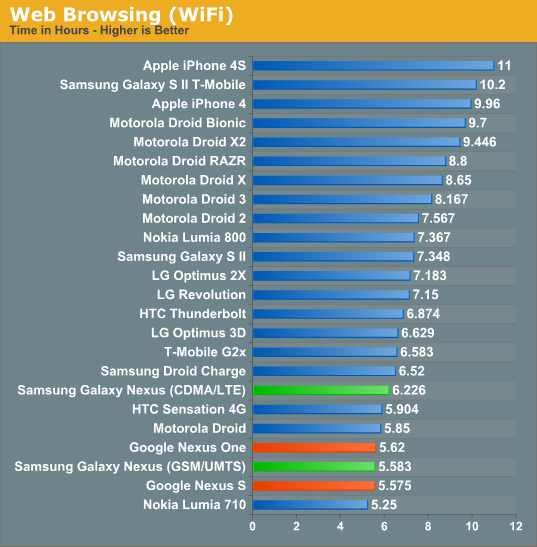
Surprisingly, the Galaxy Nexus can't break past that 6 hour mark even on WiFi, however, which does lead me to think we might be constrained by driving that display.
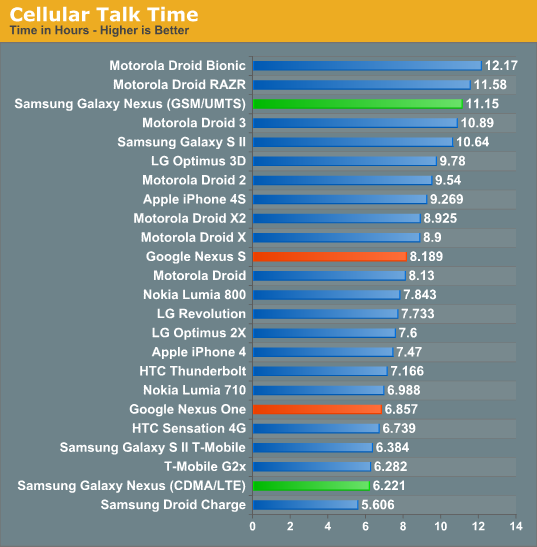
If you ever wanted to see how much difference having a different cellular architecture makes, see above. The GSM/UMTS Galaxy Nexus lasts impressively long on a voice call, at over 11 hours, yet its CDMA/LTE brother lasts just over half that.
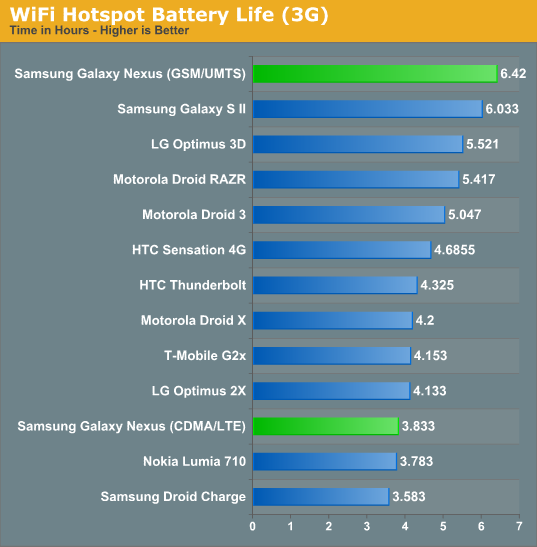
WiFi hotspot on 3G tells the same story - I'm not sure what Via Telecom's CBP7.1 draws in its active state for EVDO or 1x voice, but it seems to eat up more power than the XMM 6260 (X-Gold 626) in the GSM/UMTS Galaxy Nexus.
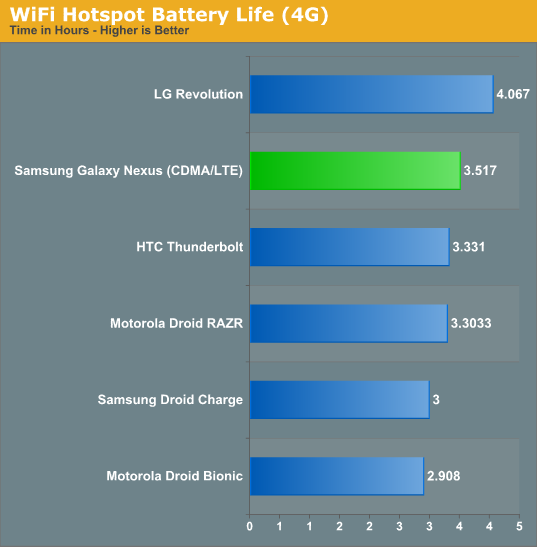
As a 4G LTE WiFi hotspot, the Galaxy Nexus loses its edge over the Revolution, but does come in just ahead of the rest of the 4G LTE herd.
The story of battery life on the Galaxy Nexus unsurprisingly depends on which variant you're talking about. For a phone with a 4.65" display, I'd say I'm impressed with the battery life on both devices - remember that the area that needs to get lit up goes as r^2 - increasing that and not killing the battery is a big feat. In addition, I'd wager that using the OpenGL ES renderpath (and accelerated browser in 4.0) definitely helped both Galaxy Nexus devices post impressive scores. As for the two variants, the GSM/UMTS device has impressively long battery life pretty much across the board. Playing with that phone, I was rarely wanting for more on my regular use schedule (I charge at night on my nightstand). We've seen XMM6260 before in numerous devices where it seems to be a pretty good citizen.
The CDMA/LTE variant, on the other hand, depends strongly on what air interface you end up using most - on 4G LTE the device comes in at the front of the pack usually, and its 3G web browsing test is above average. However, if you make a lot of voice calls, the phone might not cut it. Unsurprisingly the CDMA/LTE Galaxy Nexus does nothing to dramatically change 4G LTE battery life - for that we're still waiting for upcoming 28nm LTE basebands.










185 Comments
View All Comments
dryphi - Saturday, March 10, 2012 - link
What about the contacts list?One of my biggest pet peeves with previous versions of Android is it took so long to find the person you wanted to call / text / whatever. This was because opening the "Contacts" list or the "Phonebook" necessitated you scroll down to the name of the person, through page after page of contact (if you have a lot, like I do). Another option with Android is pressing the "Search" button (in some views) would permit typing the person's name, although this feature has been done-away with in ICS.
Compare these two options to the iPhone, on which you could simply press the first letter of the person you were looking for and the list would jump right to it.
As a result of the aforementioned frustration, my Android device often makes for a better mobile web browser than it does a mobile phone!
How does ICS address this issue? Did they finally adopt the alphabet list to the right of your contacts like the iPhone? Or do they provide another way of searching for contacts?
Kuzma30 - Wednesday, March 28, 2012 - link
Hello.Need more information about decompile ducati-m3.bin. I need change watchdog timer from 11 to 10 in ducati firmware. Can you help me?
vineeth - Monday, April 9, 2012 - link
I can't believe that after so many iterations, they just can't get it right. It pisses me off that when you zoom out of a webpage you get those white spaceseio - Saturday, April 21, 2012 - link
it's Camera ICShttps://play.google.com/store/apps/details?id=com....
an app based on ICS stock camera app code, but exposed many advanced settings, like bitrate in video =)
that result in significantly better video quality, especially at 1080p.
really made me wonder why google didn't include those features in their official rom
rs1709 - Sunday, April 29, 2012 - link
Have you had a chance to revisit this subject. With support being available when buying the device from Google direct is there anything that has changed ?